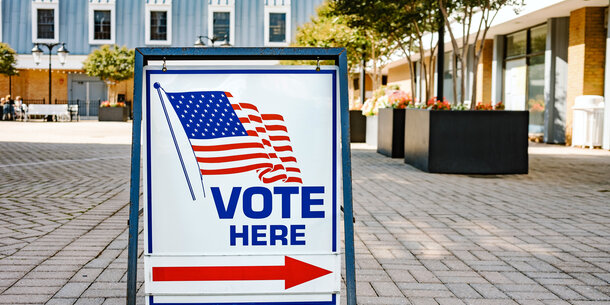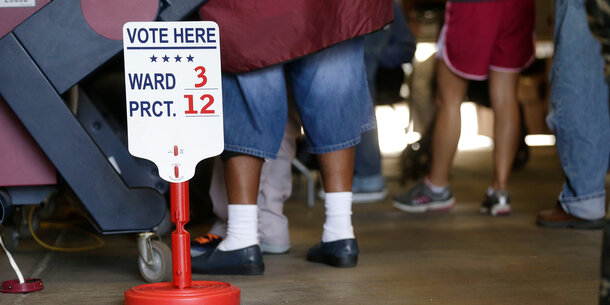Celebrated as a crowning legislative achievement of the civil rights era, the Voting Rights Act was adopted to guarantee that all Americans enjoy the right to vote regardless of race. On Wednesday morning, the Supreme Court heard arguments in a case that may destroy one of the law’s key tools of enforcement.
In March 1965 in Selma, Alabama, nonviolent protestors marched across the Edmund Pettus Bridge and faced attacks at the hands of state police, sacrificing their bodies for the cause of equal access to the ballot. The widespread public reaction to the televised footage of the incident led President Lyndon Johnson and Congress to enact the Voting Rights Act. The law, passed with bipartisan support, forbade state and local policies and practices that would deny or prevent people from voting because of their race. Later amendments prohibited not only policies that were intentionally discriminatory but also those that produced discriminatory effects.
Part of the “Second Reconstruction,” the Voting Rights Act aimed to settle the prolonged struggle to make good on the promises contained in the 14th and 15th Amendments — America’s answer to its original sin of enslavement. From the moment of its adoption, the law helped reshape political bodies from the local to the federal level and dramatically expanded the electorate. It shielded against new discriminatory voting laws and schemes to dilute voting power. And it gave voters of color the right to challenge existing rules that denied the equal opportunity to elect candidates of their choice. Republicans and Democrats repeatedly embraced the statute, last reauthorizing the law in 2006 (when Republicans controlled the White House and both chambers of Congress).
Throughout its history, however, the Voting Rights Act has also faced attacks. In recent years, it has been weakened by the Supreme Court. In the 2013 case Shelby County v. Holder, for example, the Court effectively tossed out Section 5 of the law, a provision requiring certain states (most of them in the South) to get approval from the federal government before changing voting rules. In her dissenting opinion, Justice Ruth Bader Ginsburg famously said that decision was like “throwing away your umbrella in a rainstorm because you are not getting wet.”
She has been proven right. In the years since, states have enacted dozens of laws making it harder to vote. A Brennan Center report found that since 2008, the racial turnout gap — the difference in voter participation between white and nonwhite citizens — has consistently increased, reaching 18 percentage points in the 2022 midterms. And the shift is most pronounced in the very places where Section 5 used to apply.
In its decision to eliminate Section 5, though, the Supreme Court was quick to point out that Section 2 remained a valid tool to enforce the Voting Rights Act. That reassurance leads us to the troubling case before the Court Wednesday. In Louisiana v. Callais, the Court has invited argument on whether Section 2 is unconstitutional. Put another way, the Court will tell us whether this civil rights landmark and its decades of progress in securing the right to vote are to be reaffirmed or cast aside.
The case centers around Louisiana’s congressional map. In 2020, Republicans in the state drew a map that blatantly diluted the Black electorate. Black Louisianans comprised a third of the state’s population but had a realistic shot at electing a candidate in just one of six created districts. Black voters sued under Section 2, and a court struck down the map, forcing state lawmakers back to the drawing board. The court had offered alternative maps to comply with Section 2, but lawmakers drew a different map to cater to their partisan interests. A group of white voters then challenged the new map, arguing that it was predominantly race-driven and violated the Equal Protection Clause in the 14th Amendment.
Last year, the Supreme Court considered ruling on that challenge but surprisingly delayed its decision and invited the parties to address a high-stakes and perilous question: Is Section 2 itself constitutional?
The State of Louisiana now argues that it and other states shouldn’t be required to take race into account when drawing maps at all. This argument applies a peculiar reading of the 14th Amendment, the core of Reconstruction and the civil rights revolution, to demand a rollback of protections against the very tactics that Reconstruction saw coming. The argument invites a return to the era when race was a barrier to entry for political representation — the cruel and painful experience of political exclusion that made passage of the Voting Rights Act necessary in the first place.
To be clear, race discrimination in voting isn’t merely a thing of the past. Repeatedly in Louisiana, as in several other states in recent years, courts have found both intentional discrimination and vote dilution that have denied equal political opportunity and contributed to a growing racial gap. In the Supreme Court arguments Wednesday, at least some justices appeared open to the concept of either severely limiting Section 2 or eliminating the provision altogether. The latter result would (as we explained in our friend-of-the-court brief) inject chaos into the redistricting process at every level of government, right on the eve of a national election.
No matter the outcome, it ultimately remains our collective charge as Americans to defend the equal right to vote. In 1965, it took the courage and determination of protesters marching in Selma to ensure equal access to the ballot. Today, it will take all of us to engage at all levels of government and bring about a renewed push to reaffirm our most fundamental constitutional values.



